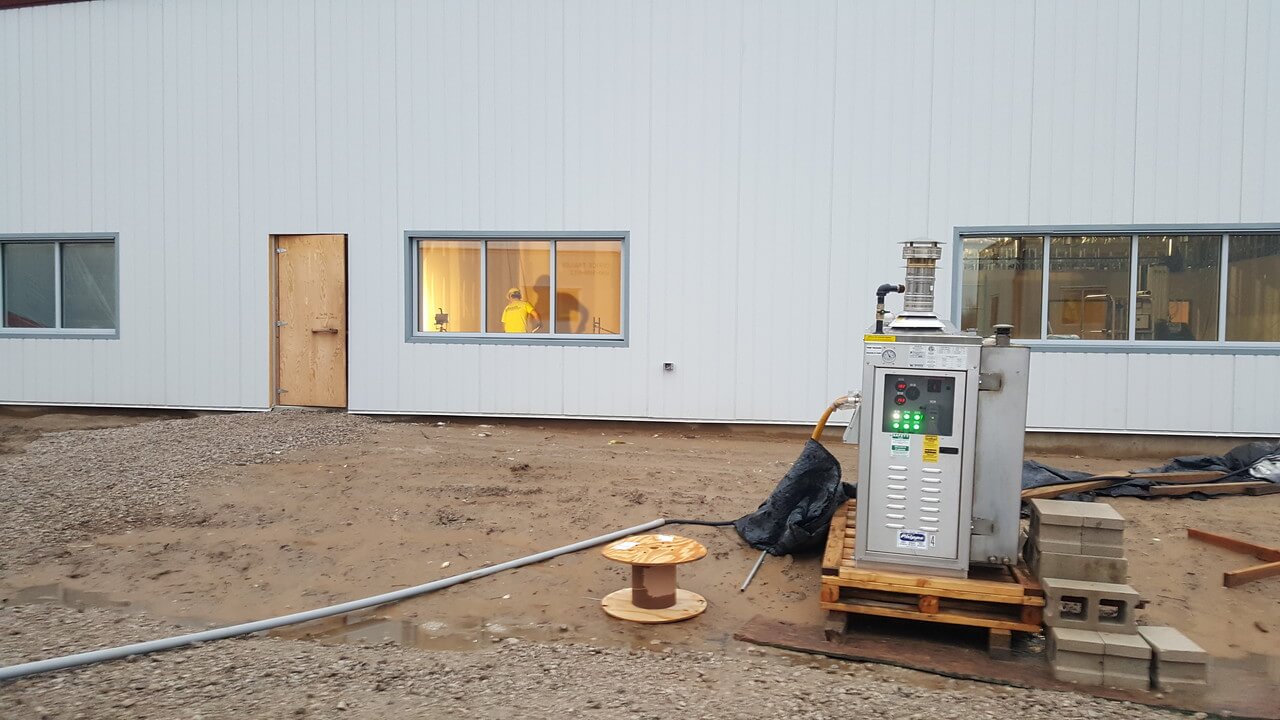CO2 Levels and Temporary Construction Heating
Posted by Matt Milos on Sep 24th 2018
 With winter right around the corner it is time to start thinking about how we are going to heat our structures.
With winter right around the corner it is time to start thinking about how we are going to heat our structures.
While weather is unpredictable, without temporary construction heating the jobsite will quickly get too cold for work to progress.
“No problem!” you might think, “we’ll just run a temporary gas line and plug in the old stand-by direct-fired “torpedo” heater. They are relatively inexpensive and very common form of temporary construction heating.”

Most job-sites use the familiar direct-fired "torpedo" heater.
So why wouldn’t you do that?
Before I answer this, let’s review what combustion is, taken from the TSI Combustion Analysis Basics Handbook:
Combustion occurs when fossil fuels, such as natural gas, fuel oil, coal or gasoline, react with oxygen in the air to produce heat. The heat from burning fossil fuels is used for industrial processes, environmental heating or to expand gases in a cylinder and push a piston. Boilers, furnaces and engines are important users of fossil fuels. Fossil fuels are hydrocarbons, meaning they are composed primarily of carbon and hydrogen. When fossil fuels are burned, carbon dioxide (CO2) and water (H2O) are the principle chemical products, formed from the reactants carbon and hydrogen in the fuel and oxygen (O2) in the air. The simplest example of hydrocarbon fuel combustion is the reaction of methane (CH4), the largest component of natural gas, with O2 in the air. When this reaction is balanced, or stoichiometric, each molecule of methane reacts with two molecules of O2 producing one molecule of CO2 and two molecules of H2O. When this occurs, energy is released as heat.

Combustion at the molecular level: you get heat, but you also get CO2.
At its simplest form, combustion means inputting fuel and generating heat by chemical reaction. Perfect! This is exactly what we are seeking. Unfortunately, it is not quite that easy.
As with any chemical reaction, there are biproducts:
The combining of oxygen in the air and carbon in the fuel to form carbon dioxide and generate heat is a complex process, requiring the right mixing turbulence, sufficient activation temperature and enough time for the reactants to come into contact and combine. Unless combustion is properly controlled, high concentrations of undesirable products can form. Carbon monoxide (CO) and soot, for example, result from poor fuel and air mixing or too little air. Other undesirable products, such as nitrogen oxides (NO, NO2), form in excessive amounts when the burner flame temperature is too high.

OSHA limits CO2 exposure based on time.
These carbon molecules harmful, even if coming only from temporary construction heating.
According to OSHA, the acceptable level for temporary exposure is 50ppm and 5000ppm for CO2. However, as this article from Occupational Health and Safety online points out, there is more to the story than just that:
The true concentration of CO2 could be substantially higher if the oxygen deficiency is due to displacement rather than consumption of the oxygen in the confined space. Fresh air contains only 20.9 percent oxygen by volume. The balance consists mostly of nitrogen, with minor or trace concentrations of a wide variety of other gases, including argon, water vapor, and carbon dioxide. Because oxygen represents only about one-fifth of the total volume of fresh air, every 5 percent of a displacing gas that is introduced into a confined space reduces the oxygen concentration by only 1 percent. As an example, consider an oxygen deficiency due to the introduction of dry ice into an enclosed space. In this case, a reading of 19.5 percent O2 would not be indicative of 1.4 percent CO2, it would be indicative of 5 X 1.4 percent = 7.0 percent (= 70,000 ppm) CO2.
The bottom line is that if you wait until the oxygen deficiency alarm is activated, and the deficiency is due to the presence of CO2, you will have substantially exceeded the toxic exposure limit long before leaving the affected area.

Managing warm air with clean air can be a difficult balance with traditional heating systems.
Depending on the structure's volume, it can be impossible to achieve safe CO and CO2 levels without introducing fresh air from outside.
Doing so creates a dilemma. You heat the structure to maintain work-safe temperatures. This increases CO and CO2 levels, so you need fresh air fresh to lower the levels. Air from the outside is much cooler than the air inside so you add energy to bring temperature back up. This creates a vicious cycle where the needs for safe air and warm air are in conflict. Managing this conflict quickly becomes costly and time-consuming.

Hydronic heating keeps fumes where they belong: away from workers.
Thanks to technology the "warm air vs. clean air" battle is one construction professionals no longer have to wage.
Hydronic heating allows for an economic solution that eliminates any fumes inside the building. The heating unit sits outside the work area (leaving combustion outside) where it flash-heats food-grade glycol to 180 degrees. It then pumps that glycol into the work area where thermostatically controlled exchangers distribute the heat. It is the closest thing to having a permanent system on a temporary basis as you can get. This not only allows for massive fuel savings, but, more importantly, it also creates a safe, emission-free environment. No more need to constantly worry about minute-to-minute CO2 levels.
Let your crew focus on their work this winter, resting easy knowing a hydronic system is taking care of it.


